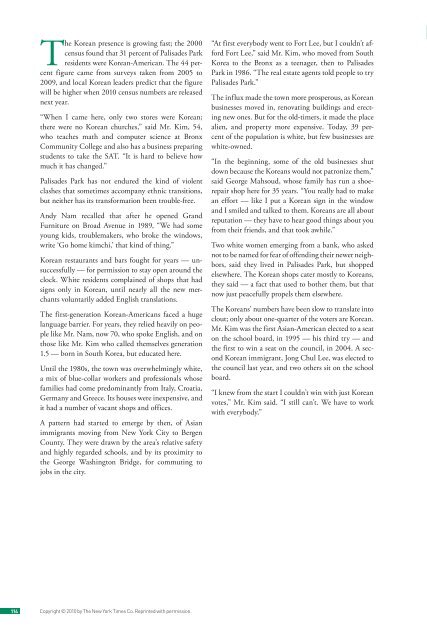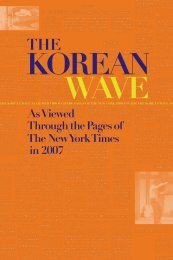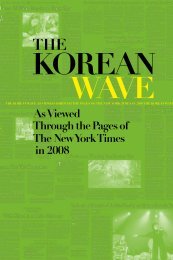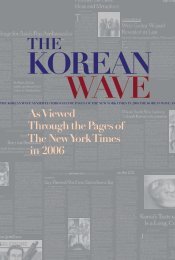The Korean Wave 2010-2011 - Korean Cultural Service
The Korean Wave 2010-2011 - Korean Cultural Service
The Korean Wave 2010-2011 - Korean Cultural Service
Create successful ePaper yourself
Turn your PDF publications into a flip-book with our unique Google optimized e-Paper software.
<strong>The</strong> <strong>Korean</strong> presence is growing fast; the 2000census found that 31 percent of Palisades Parkresidents were <strong>Korean</strong>-American. <strong>The</strong> 44 percentfigure came from surveys taken from 2005 to2009, and local <strong>Korean</strong> leaders predict that the figurewill be higher when <strong>2010</strong> census numbers are releasednext year.“When I came here, only two stores were <strong>Korean</strong>;there were no <strong>Korean</strong> churches,” said Mr. Kim, 54,who teaches math and computer science at BronxCommunity College and also has a business preparingstudents to take the SAT. “It is hard to believe howmuch it has changed.”Palisades Park has not endured the kind of violentclashes that sometimes accompany ethnic transitions,but neither has its transformation been trouble-free.Andy Nam recalled that after he opened GrandFurniture on Broad Avenue in 1989, “We had someyoung kids, troublemakers, who broke the windows,write ‘Go home kimchi,’ that kind of thing.”<strong>Korean</strong> restaurants and bars fought for years — unsuccessfully— for permission to stay open around theclock. White residents complained of shops that hadsigns only in <strong>Korean</strong>, until nearly all the new merchantsvoluntarily added English translations.<strong>The</strong> first-generation <strong>Korean</strong>-Americans faced a hugelanguage barrier. For years, they relied heavily on peoplelike Mr. Nam, now 70, who spoke English, and onthose like Mr. Kim who called themselves generation1.5 — born in South Korea, but educated here.Until the 1980s, the town was overwhelmingly white,a mix of blue-collar workers and professionals whosefamilies had come predominantly from Italy, Croatia,Germany and Greece. Its houses were inexpensive, andit had a number of vacant shops and offices.A pattern had started to emerge by then, of Asianimmigrants moving from New York City to BergenCounty. <strong>The</strong>y were drawn by the area’s relative safetyand highly regarded schools, and by its proximity tothe George Washington Bridge, for commuting tojobs in the city.“At first everybody went to Fort Lee, but I couldn’t affordFort Lee,” said Mr. Kim, who moved from SouthKorea to the Bronx as a teenager, then to PalisadesPark in 1986. “<strong>The</strong> real estate agents told people to tryPalisades Park.”<strong>The</strong> influx made the town more prosperous, as <strong>Korean</strong>businesses moved in, renovating buildings and erectingnew ones. But for the old-timers, it made the placealien, and property more expensive. Today, 39 percentof the population is white, but few businesses arewhite-owned.“In the beginning, some of the old businesses shutdown because the <strong>Korean</strong>s would not patronize them,”said George Mahsoud, whose family has run a shoerepairshop here for 35 years. “You really had to makean effort — like I put a <strong>Korean</strong> sign in the windowand I smiled and talked to them. <strong>Korean</strong>s are all aboutreputation — they have to hear good things about youfrom their friends, and that took awhile.”Two white women emerging from a bank, who askednot to be named for fear of offending their newer neighbors,said they lived in Palisades Park, but shoppedelsewhere. <strong>The</strong> <strong>Korean</strong> shops cater mostly to <strong>Korean</strong>s,they said — a fact that used to bother them, but thatnow just peacefully propels them elsewhere.<strong>The</strong> <strong>Korean</strong>s’ numbers have been slow to translate intoclout; only about one-quarter of the voters are <strong>Korean</strong>.Mr. Kim was the first Asian-American elected to a seaton the school board, in 1995 — his third try — andthe first to win a seat on the council, in 2004. A second<strong>Korean</strong> immigrant, Jong Chul Lee, was elected tothe council last year, and two others sit on the schoolboard.“I knew from the start I couldn’t win with just <strong>Korean</strong>votes,” Mr. Kim said. “I still can’t. We have to workwith everybody.”THE NEW YORK TIMES BOOK REVIEW, Sunday, April 3, <strong>2011</strong>Look After Mom,” by the South<strong>Korean</strong> writer Kyung-sook Shin, opens“Pleasewith a family in disarray. Mom is missing,separated from Father by the closing doors of a subwaycar in a busy train station in Seoul. A day, a week, thennearly a month goes by. Mom’s husband and adultchildren are not only worried, but crippled with guiltand regret, fumbling “in confusion, as if they had allinjured a part of their brains.” Are you punishing me?each privately wonders.<strong>The</strong> eldest daughter, Chi-hon, is the writer of her family,and she is persuaded to draft the missing-person fliers.“Appearance: Short, salt-and-pepper permed hair,prominent cheekbones,” she writes, “last seen wearinga sky-blue shirt, a white jacket and a beige pleatedskirt.” When Chi-hon thinks back on the Mom of herchildhood, she sees a woman who “strode through thesea of people in a way that would intimidate even theauthoritative buildings looking on from above.” <strong>The</strong>strangers who respond to her ads paint a different picture:“<strong>The</strong>y saw an old woman walking very slowly,sometimes sitting . . . or standing vacantly.” Could itbe the same woman?Shin’s novel, her first to be translated into English, embracesmultiplicity. It is told from the perspectives offour members of the family, and from their memoriesemerges a portrait of a heroically selfless and industriouswoman. She runs their rural home “like a factory.”She sews and knits and tills the fields, and raisespuppies, piglets, ducklings and chickens. <strong>The</strong> familyis poor, but she sees to it that her children’s bellies arefilled, their tuition fees paid.Only after her children grow up and leave their homein Chongup does Mom’s strength and purposefulnessbegin to flag. When Chi-hon visits unannounced, shefinds the house in shambles and Mom suffering privateLost in TransitBY MYTHILI G. RAOanguish. <strong>The</strong> daughter is stunned: “Mom got headaches?So severe that she couldn’t even cry?” <strong>The</strong>se aresome of the many questions that punctuate her narrativeand lead to a cascade of revelations. Mom’s debilitatingheadaches are the byproduct of a stroke she toldno one about. Other discoveries come gradually. Afterone of Chi-hon’s older brothers leaves the village forSeoul, she is responsible for writing letters to him, dictatedby Mom. For years, Chi-hon assumes this is justan additional chore. <strong>The</strong> reality is revealed in anotherquestion she asks of herself: “When was it you realizedthat Mom didn’t know how to read?”Shin’s prose, intimate and hauntingly spare in thistranslation by Chi-Young Kim, moves from first tosecond and third person, and powerfully conveysgrief’s bewildering immediacy. Chi-hon’s voice is thenovel’s most distinct, but Father’s is the most devastating.Returning to the house in Chongup, he is “bludgeoned”with Mom’s absence as he realizes that henever fully appreciated her, this “steadfast tree” at thecenter of his life — and that all this time he had beenin denial over her health’s deterioration.“<strong>The</strong> word ‘Mom’ is familiar,” Chi-hon observes, “and ithides a plea: Please look after me.” Passages of the novelmay cause the grown children among Shin’s readers tocringe. (“You were the one who always hung up first,”Chi-hon mournfully remembers of her own behavior.“You would say, ‘Mom, I’ll call you back,’ and then youdidn’t.”) And yet this book isn’t as interested in emotionalmanipulation as it is in the invisible chasms thatopen up between people who know one another best.Who is the missing woman? In this raw tribute to themysteries of motherhood, only Mom knows.Mythili G. Rao has written for <strong>The</strong> New York Observer, WordsWithout Borders and Boston Review.23114 Copyright © <strong>2010</strong> by <strong>The</strong> New York Times Co. Reprinted with permission.Copyright © <strong>2011</strong> by <strong>The</strong> New York Times Co. Reprinted with permission. 115





